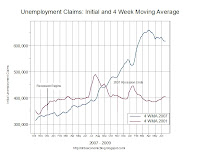
As I have mentioned in previous posts, Robert J. Gordon did research looking at the relationship between the 4 week moving average of initial unemployment claims and found that recessions often bottom out shortly after the 4-week moving average of initial unemployment claims peaks. The average may have peaked at 658,750 for the week ended April 4, 2009. On June 26, 2009 the Department of Labor released the most recent data on initial unemployment claims for the week ended June 20, 2009 in "Unemployment Insurance Weekly Claims Report." Seasonally adjusted initial claims was 627,000, up 15,000 from a revised estimate of initial claims of 612,000 for the week ended June 13, 2009. The 4 Week moving average increased 500 to 617,250. The average is down 41,500 from its peak, signaling a possible peak for this business cycle. Even though the average has declined, initial claims are still very high.Using National Bureau of Economic Research estimates on the beginning and ending dates of recessions, I have also included a graph that compares the recession that began in March 2001 with the current recession which began in December 2007. Both graphs are measured over 92 weeks, beginning eight weeks before the recessions began. The horizontal axes begins in October 2007, and the data for the 2001 recession is superimposed on those dates. The graph gives some insight into why economists, politicians and others have expressed so much concern about the current recession. As time permits, I will add data from other recessions to the graph.
Replace this text with...



Dr. Brooks,
ReplyDeleteI have read your past couple of blogs about unemployment, and all I have to say is that it stinks that I have to try to find a job in it, but it has given me some insight on what will help me. Thanks. These blogs have been very interesting.
Your student,
Lindsey Scott